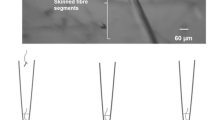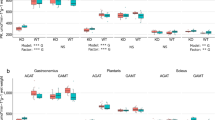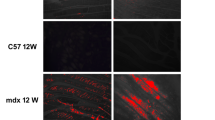Summary
Creatine kinase (CK) isoenzyme compositions of different types of single muscle fibres dissected from soleus (SOL) and extensor digitorum longus (EDL) muscles from rats were examined. CK isoenzymes were separated into cytoplasmic (CK-MM, CK-MB, CK-BB) (muscle, brain and hybrid types, respectively) and mitochondrial (m-CK) isoenzymes. Total CK and CK-MM activities showed the highest activities in fast-twitch glycolytic fibres (FG), lower in fast-twitch oxidative glycolytic (FOG) and the lowest in slow-twitch oxidative (SO) fibres. Conversely, the activity of m-CK was highest in SO, lowest in FG and intermediate in FOG fibres. The activity of CK-MB was highest in SO and lower in FOG and FG fibres. However, the activities of total CK and CK isoenzymes in a single muscle fibre type were not distinguishable from those of another type, and the profiles of CK isoenzyme compositions from the same type of single muscle fibres overlapped over a considerable range. The relationships between the four CK isoenzymes activities in single muscle fibres of different types were not similar. These results suggest that CK isoenzymes of single muscle fibres of different types play different roles in intracellular energy metabolism. Therefore, it is supposed that the CK isoenzyme compositions of single muscle fibres are suitable for their contractive and metabolic properties.
Similar content being viewed by others
References
Apple, F. S., Rogers, M. A., Sherman, W. M., Costill., D. L., Hagerman, F. C. &Ivy, J. L. (1984) Profile of creatine kinase isoenzymes in skeletal muscle of marathon runners.Clin. Chem. 30, 413–16.
Apple, F. S. &Tesch, P. A. (1989) CK and LD isoenzymes in human single muscle fibers in trained athletes.J. Appl. Physiol. 66, 2717–20.
Armstrong, R. B. &Phelps, R. O. (1984) Muscle fiber type composition of rat hindlimb.Am. J. Anat. 171, 259–72.
Bárány, M. (1967) ATPase activity of myosin correlated with speed of muscle shortening.J. Gen. Physiol. 50, 197–218.
Bessman, S. P. &Geiger, P. J. (1981) Transport of energy in muscle: the phosphorylcreatine shuttle. Science211, 448–52.
Bessman, S. P., Yang, W. C. T., Geiger, P. J. &Ericksonviitanen, S. (1980) Intimate coupling of creatine phosphokinase and myofibrillar adenosinetriphosphatase.Biochem. Biochim. Res. Commun. 96, 1414–20.
Blum, H. E., Deus, B. &Gerok, W. (1983) Mitochondrial creatine kinase from human heart muscle: Purification and characterization of the crystallized isoenzyme.J. Biochem. 94, 1247–57.
Dawson, D. M., Eppenberger, H. M. &Kaplan, N. O. (1965) Creatine kinase: Evidence for a dimeric structure.Biochem. Biophys.Res.Commun. 21, 346–53.
Eppenberger, H. M., Dawson, D. M. &Kaplan, N. O. (1967) The comparative enzymology of creatine kinases. I. Isolation and characterization from chicken and rabbit tissues.J. Biol. Chem. 242, 204–9.
Feeback, L., Locklear, I. &Brumback, R. A. (1988) Metabolic myopathy produced by dinitrofluorobenzene inhibition of creatine phosphokinase.J. Neurol. Sci. 88, 219–28.
Gellerich, F. &Saks, V. A. (1982) Control of heart mitochondrial oxygen consumption by creatine kinase: The importance of enzyme location.Biochem. Biochim. Res. Commun. 105, 1473–81.
Goto, I., Nagamine, M. &Katsuki, S. (1969) Creatine phosphokinase isoenzymes in muscles. Human fetus and patients.Arch. Neuol. 20, 422–29.
Goldberg, M. L. (1973) Quantitative assay for submicrogram amounts of protein.Anal. Biochem. 51, 240–46.
Guth, L. &Samaha, F. (1970) Procedure for the histochemical demonstration of actomyosin ATPase.Exp. Neurol 28, 365–67.
Jansson, E. &Sylven, C. (1985) Creatine Kinase MB and citrate synthase in type I and type II muscle fibres in trained and untrained men.Eur. J. Appl. Physiol. 54, 207–9.
Mercer, D. W. (1974) Separation of tissue and serum creatine kinase isoenzymes by ion exchange column chromatography.Clin. Chem. 20, 36–40.
Nachlas, M. M., Tsou, K. C., Souza, E. D., Cheng, C. S. &Seligman, A. M. (1957) Cytochemical demonstration of succinate dehydrogenase by the use of a new p-nitrophenyl substituted ditetrazole.J. Histochem. Cytochem.5, 420–36.
Neumeier, D. (1981) Tissue specific and subcellular distribution of creatine kinase isoenzymes. InCreatine kinase isoenzymes (edited byLang, H.), pp. 85–109. New York: Springer Verlag.
Peter, J. B., Barnard, R. J., Edgerton, V. R., Gillespie, C. A. &Stempel., K. E. (1972) Metabolic profiles of three fiber types of skeletal muscle in guinea pig and rabbits.Biochemistry 11, 2627–33.
Sadeh, M., Stern L. Z., Czyzewski, K., Finley, P. R. &Russel., D. H. (1984) Alterations in creatine kinase, ornithine decarboxylase, and transglutaminase during muscle regeneration.Life Sci. 34, 483–88.
Saks, V. A., Chernousova, G. B., Voronkov, I. I., Smirnov, V. N. &Chazov, E. I. (1974) Study of energy transport mechanism in myocardial cells.Cir. Res. 34–35 (Suppl. III), 138–49.
Saks, V. A., Rosenshtraukh, L. V., Smirnov, V. N. &Chazov, E. I. (1978) Role of creatine phosphokinase in cellular function and metabolism.Can. J. Physiol. Pharmacol. 56, 691–706.
Schlegal., J., Zurbriggen, B., Wegmann, G., Wyss, M., Eppenberger, H. M. &Wallimann, T. (1988) Native mitochondrial creatine kinase forms octameric structures. I. Isolation of two interconvertible mitochondrial creatine kinase forms, dimeric and octameric mitochondrial creatine kinase: Characterization, localization, and structure-function relationships.J. Biol. Chem. 263 16942–53.
Schmitt, T. &Pette, D. (1985) Increased mitochondrial creatine kinase in chronically stimulated fast-twitch rabbit muscle.FEBS Lett. 188, 341–44.
Scholte, H. R., Weijers, P. J. &Wit-Peeters, E. M. (1973) The localization of mitochondrial creatine kinase, and its use for the determination of the sidedness of submitochondrial particles.Biochim. Biophys. Acta 291, 764–73.
Sylven, C., Jansson, E., Kallner, A. &Book, K. (1984) Human creatine kinase. Isoenzymes and logistics of energy distribution.Scand. J. Clin. Lab. Invest. 44, 611–15.
Takahashi, K., Ushikubo, S., Oimomi, M. &Shinko, T. (1972) Creatine phosphokinase isoenzyme of human heart muscle and skeletal muscle.Clin. Chim. Acta 38, 285–90.
Takekura, H. &Yoshioka, T. (1987) Determination of metabolic profiles on single muscle fibres of different types.J. Muscle Res Cell Motil. 8, 342–48.
Takekura, H. &Yoshioka, T. (1989) Ultrastructural and metabolic profiles on single muscle fibers of different types after hindlimb suspension in rats.Jpn. J. Physiol. 39, 385–396.
Tesch, P. A., Thorsson, A. &Fujitsuka, N. (1989) Creatine phosphate in fiber types of skeletal muscle before and after exhaustive exercise.J. Appl. Physiol. 66, 1756–59.
Turner, D. C., Wallimann, T. &Eppenberger, H. M. (1973) A protein that binds specifically to the M-line of skeletal muscle is identified as the muscle form of creatine kinase.Proc. Natl. Acad. Sci. USA 70, 702–5.
Wallimann, T., Pelloni, G., Turner, D. C. &Eppenberger, H. M. (1978) Movement antibodies against MM-creatine kinase remove the M line from myofibrils.Proc. Natl. Acad. Sci. USA 75, 4296–300.
Wallimann, T., Schlosser, T. &Eppenberger, H. M. (1984) Function of M-line-bound creatine kinase as intramyofibrillar ATP regenerator at the receiving end of the phosphorylcreatine shuttle in muscle.J. Biol. Chem. 259, 5238–46.
Wallimann, T., Schnyder, T., Schlegel., J., Wyss, M., Wegmann, G., Rossi, A.-M., Hemmer, W., Eppenberger, H. M. andQuest, A. F. G. (1989) Muscle energetic. InProgress in clinical and biological research (edited by Paul, R. J., Elzinga, G. and Yamada, K.), pp 159–76. New York: Alan R. Liss, Inc.
Weselakc, R. J. &Jacobs, H. K. (1983) Separation of cytoplasmic and mitochondrial isoenzymes of creatine kinase by hydrophobic interaction chromatography.Clin. Chim. Acta 134, 357–61.
Author information
Authors and Affiliations
Rights and permissions
About this article
Cite this article
Yamashita, K., Yoshioka, T. Profiles of creatine kinase isoenzyme compositions in single muscle fibres of different types. J Muscle Res Cell Motil 12, 37–44 (1991). https://doi.org/10.1007/BF01781172
Accepted:
Issue Date:
DOI: https://doi.org/10.1007/BF01781172




